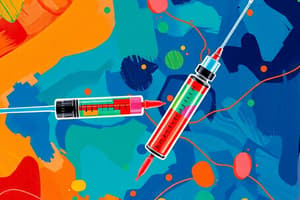Podcast
Questions and Answers
What is the primary purpose of parenteral administration?
What is the primary purpose of parenteral administration?
- To inject a drug into the body tissues (correct)
- To apply medication topically on the skin
- To inhale medication into the lungs
- To administer medication orally
Which injection technique involves injecting a substance into the dermis, just below the epidermis?
Which injection technique involves injecting a substance into the dermis, just below the epidermis?
- Subcutaneous (SC)
- Intradermal (ID) (correct)
- Intravenous (IV)
- Intramuscular (IM)
Which of the following injection sites poses a risk of damaging the sciatic nerve if not performed correctly?
Which of the following injection sites poses a risk of damaging the sciatic nerve if not performed correctly?
- Dorsal gluteal region (correct)
- Vastus Lateralis
- Deltoid region
- Anterolateral thigh
If a patient has a significant amount of subcutaneous tissue, what adjustment should be made when administering a subcutaneous injection?
If a patient has a significant amount of subcutaneous tissue, what adjustment should be made when administering a subcutaneous injection?
Why is it important to avoid mixing medications that undergo alteration?
Why is it important to avoid mixing medications that undergo alteration?
Which action is essential for preventing needle contamination during an injection?
Which action is essential for preventing needle contamination during an injection?
What is the MOST appropriate action if blood is aspirated during an intramuscular injection?
What is the MOST appropriate action if blood is aspirated during an intramuscular injection?
After administering an intradermal injection for diagnostic testing, why is it crucial to observe the site?
After administering an intradermal injection for diagnostic testing, why is it crucial to observe the site?
According to the general precautions, what should be checked before using any material for an injection procedure?
According to the general precautions, what should be checked before using any material for an injection procedure?
What needle gauge range is recommended for extracting fluid from a vial?
What needle gauge range is recommended for extracting fluid from a vial?
Which action helps minimize the risk of infection when preparing the skin for an injection?
Which action helps minimize the risk of infection when preparing the skin for an injection?
Which of the following is the correct angle for inserting a needle for an intradermal injection?
Which of the following is the correct angle for inserting a needle for an intradermal injection?
What does the appearance of a wheal (pápula) after an intradermal injection indicate?
What does the appearance of a wheal (pápula) after an intradermal injection indicate?
Which of the following is NOT a recommended site for subcutaneous injections?
Which of the following is NOT a recommended site for subcutaneous injections?
What action should be avoided when administering insulin subcutaneously?
What action should be avoided when administering insulin subcutaneously?
What is the MOST important consideration when selecting a needle length for a subcutaneous injection?
What is the MOST important consideration when selecting a needle length for a subcutaneous injection?
Which of the following actions increases patient safety when using a needle?
Which of the following actions increases patient safety when using a needle?
When administering a subcutaneous injection, what angle of insertion is typically used?
When administering a subcutaneous injection, what angle of insertion is typically used?
What is the primary reason for aspirating before injecting a medication intramuscularly?
What is the primary reason for aspirating before injecting a medication intramuscularly?
Which muscle is NOT recommended for intramuscular injections in children under 3 years due to the risk of contacting the sciatic nerve?
Which muscle is NOT recommended for intramuscular injections in children under 3 years due to the risk of contacting the sciatic nerve?
Which site is preferred for intramuscular injections because it is away from major nerves and blood vessels?
Which site is preferred for intramuscular injections because it is away from major nerves and blood vessels?
What is the recommended action after inserting the needle into the muscle during an intramuscular injection?
What is the recommended action after inserting the needle into the muscle during an intramuscular injection?
Why is the Z-track method used in intramuscular injections?
Why is the Z-track method used in intramuscular injections?
During intravenous (IV) medication administration, what action is MOST critical to ensure patient safety?
During intravenous (IV) medication administration, what action is MOST critical to ensure patient safety?
Before administering a medication intravenously, what should the nurse verify to ensure the right medication is given?
Before administering a medication intravenously, what should the nurse verify to ensure the right medication is given?
What is the purpose of using a saline lock (PRN adapter) for intravenous medication administration?
What is the purpose of using a saline lock (PRN adapter) for intravenous medication administration?
What sign at the IV insertion site requires immediate intervention?
What sign at the IV insertion site requires immediate intervention?
What action is important when a patient reports pain at the IV insertion site during an infusion?
What action is important when a patient reports pain at the IV insertion site during an infusion?
When administering fluids intravenously, why is it crucial to avoid introducing air into the tubing?
When administering fluids intravenously, why is it crucial to avoid introducing air into the tubing?
What is the first action a nurse should take if a patient displays signs of an allergic reaction during an intravenous infusion?
What is the first action a nurse should take if a patient displays signs of an allergic reaction during an intravenous infusion?
Flashcards
Parenteral Administration
Parenteral Administration
Injection of a drug into the body's tissues.
Intradermal (ID) Injection
Intradermal (ID) Injection
Injection into the dermis, just below the epidermis.
Subcutaneous (SC) Injection
Subcutaneous (SC) Injection
Injection into the subcutaneous tissue below the skin.
Intramuscular (IM) Injection
Intramuscular (IM) Injection
Signup and view all the flashcards
Intravenous (IV) Injection
Intravenous (IV) Injection
Signup and view all the flashcards
Medication Verification
Medication Verification
Signup and view all the flashcards
Skin Preparation
Skin Preparation
Signup and view all the flashcards
Injection site rotation
Injection site rotation
Signup and view all the flashcards
Needle Selection
Needle Selection
Signup and view all the flashcards
Intradermal Injection Volume
Intradermal Injection Volume
Signup and view all the flashcards
Intradermal Needle Insertion
Intradermal Needle Insertion
Signup and view all the flashcards
Intradermal Injection Speed
Intradermal Injection Speed
Signup and view all the flashcards
Subcutaneous injection site
Subcutaneous injection site
Signup and view all the flashcards
Subcutaneous Procedure
Subcutaneous Procedure
Signup and view all the flashcards
Intramuscular Injection
Intramuscular Injection
Signup and view all the flashcards
Dorsogluteal site
Dorsogluteal site
Signup and view all the flashcards
IM Injections precautions
IM Injections precautions
Signup and view all the flashcards
"Z track"
"Z track"
Signup and view all the flashcards
IM injection-safety
IM injection-safety
Signup and view all the flashcards
IV Injection
IV Injection
Signup and view all the flashcards
Catheters
Catheters
Signup and view all the flashcards
Check catheter
Check catheter
Signup and view all the flashcards
Phlebitis signs
Phlebitis signs
Signup and view all the flashcards
IV access veins
IV access veins
Signup and view all the flashcards
IV infiltration
IV infiltration
Signup and view all the flashcards
Venoclysis definition
Venoclysis definition
Signup and view all the flashcards
venoclysis objective
venoclysis objective
Signup and view all the flashcards
Venoclysis safety
Venoclysis safety
Signup and view all the flashcards
Venoclysis monitoring
Venoclysis monitoring
Signup and view all the flashcards
Study Notes
Parenteral Medication Administration
- Parenteral administration involves injecting a drug into body tissues.
Injection Sites
- Intradermal (ID): Injection into the dermis, just below the epidermis.
- Subcutaneous (SC): Injection into subcutaneous tissue, below the skin.
- Intramuscular (IM): Injection into a muscle.
- Intravenous (IV): Injection into a vein.
- Other parenteral routes include intratecal, intraespinal, intracardiac, intrapleural, intra-arterial, intraosseous, and intra-articular injections.
General Precautions
- Confirm materials are in good condition, clean, and sterile.
- Verify medication and dosage against the medical order.
- Do not mix substances that may interact.
- Avoid administering medications with altered color or consistency, or illegible labels.
- Consult with a healthcare provider if the order is unclear.
- Do not administer medications without a signed medical order.
- Administer and document every medication given.
- Check for allergies and potential adverse reactions.
- Change injection site if a blood vessel is punctured.
- Document and report any abnormal reactions.
- Clean a wide area before injecting medication.
- Alternate injection sites for consecutive injections.
- Use appropriate syringe size for the liquid volume.
- Use 18-20 gauge needles to withdraw liquid from a vial.
- Match needle size to the solution's consistency and the patient's physical build.
Syringe Parts and Needle Gauges
- Includes the plunger, cylinder, base, body, and bevel.
Preventing Infection During Injection
- Extract medication from ampoules quickly and avoid leaving it open.
- Prevent needle contamination by avoiding contact with non-sterile surfaces.
- Protect the syringe's body and plunger; keep the needle covered.
- Clean skin with soap and water, followed by an antiseptic solution in a circular motion from the center outwards, covering a 5 cm radius.
Intradermal Medication Administration
- Definition: Injecting a minimal amount (0.01 ml) of solution into the dermis for slow, local absorption.
Objectives
- Administering vaccines for immunization or desensitization.
- Performing diagnostic tests for allergies or specific diseases, producing local effects.
Equipment
- Includes a cart with tuberculin syringes with 26-28 gauge needles.
- Supplies include medication/vaccine, dry cottons, 70% alcohol (if not a vaccine), a file, medication card/prescription, pen, black and red waste bags, a glass waste container, and sterile gloves.
Actions/Steps
- Hand hygiene is required
- Prepare meds with checking all components
- Explain procedure and identify user
- Select the forearm
- Position patient and clean with alcohol
- Remove needle cap
- Stretch skin, insert needle at 10-15 degree
- Inject slowly to for a wheal that dissolves in 10-30 min
- Remove at same angle
Intradermal Scientific Basis
- Hand washing reduces microorganism transfer
- Proper preparation reduces errors
- Forearm is standard site for administering
- Cleaning reduces microorganisms
Subcutaneous Medication Administration (SC)
- Definition: Involves injecting a substance into the subcutaneous tissue.
Injection Sites
- The outer aspect of the upper arm's upper half.
- Abdomen (from below the costal margin to the iliac crests).
- Anterior thighs.
- Scapular regions of the upper back.
- Upper, ventral or dorsal gluteal areas.
Precautions
- Do not massage after administering insulin, vaccines, or other contraindicated medications.
- Avoid the dorsal gluteal region due to sciatic nerve damage risk.
- Select needle length carefully to prevent pain or muscle trauma.
- The chosen needle and insertion angle rely on the patient's weight, affecting the depth of the subcutaneous layer.
- Obese patients require a 90° insertion angle, not 45°.
- Rotate injection sites to prevent tissue damage.
Equipment
- Cart with insulin/tuberculin syringes with 23–25 gauge needles. Supplies include: medication/vaccine, dry cottons, 70% alcohol (if not a vaccine), file, prescription, black and red waste bags, glass waste container, and non-sterile gloves.
Steps
- Patient identity, provide privacy
- Relax the zone
- Make sure skin is appropriate
- Remove covering of needle
- Pre-aseptic cleanse
- Don't touch cap
- 5 right steps
- Clean inject site 5cm periphery, allow to dry and discard cotton
Intramuscular Medication Administration (IM)
- Definition: A technique for injecting a chemical or biological substance into muscle tissue.
Injection Site Characteristics
- Key locations: Gluteus maximus, Deltoid, Anterograde gluteal group, lateral vastus
Gluteus Maximus
- Risks touching sciatic nerve, trochanter, subyacent vessels
- Not for kids under 3 years and in ambulation
Deltoid
- Accessible, developed well in most
- For small amounts
- Not for children with small volumes
- Risk touches humeral
Anterograde Gluteal Group
- Deep, away from vessels and nerves
- Less contamintations, easy to find
- Absence of nerves, rapid drug absorbsion
Equipment
- Jeringas 3 y 5 ml (21,22,23)
- medicine, cotton
- 70% alcohol, file
IM Steps
- Validate medication, prepare and apply
- Validate Pt details, dose hours etc
- Uncap needle carefully, wipe, clean
- Angle slightly, aspirate need z method
Endovenous medication Adminstration
- Inject into vein
Objective
- Diagnose and treat
Precautions
- Patient supine / lay down
- Slow
- Remove needle air
- Use 5 rights
Equipment
- Alcohol, containers
- Tormiques
- Bandage, soap, gloves
Steps
- Card daily, wash hands
- Prepare and inject card
- Mask, Identify pt
- Vein clear and no varicose
- Clear needles. slow, stop compression
Studying That Suits You
Use AI to generate personalized quizzes and flashcards to suit your learning preferences.
Related Documents
Description
Overview of parenteral medication administration including intradermal, subcutaneous, intramuscular and intravenous injections. Discusses general precautions like verifying medication, avoiding interactions, and the importance of proper documentation. Covers various injection sites and safety measures.





